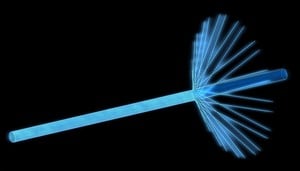Braid-Reinforced Tubing for Best Medical Use
Featured Product from Ulbrich Stainless Steels & Special Metals, Inc.

Medical tubing is an essential component in an ever-expanding array of delivery systems and related devices used in minimally invasive surgical procedures. Tubing material, wire specifications, and braiding PIC count, are all key elements used to achieve the desired level of stiffness, torque response, and other related characteristics of the tubing. Producing ultra-fine wires to extremely small dimensions that can be less than 15% the size of a human hair is only the beginning. The dimensions, mechanical properties, and cleanliness over the length of the wire must be precisely controlled.
The first steps are to ensure accuracy in the dimensions of the bobbins and winding device, and precise concentricity and alignment. The wire must be wound with an array of parameters that should be matched to the parameters that will be used in the braiding process itself, otherwise problems can occur. Biconical bobbins are sometimes used to make it easier to wind and unwind the wires, but straight-flanged bobbins work fine as long as the winding is properly controlled. The wire should be wound with slightly higher tension than the braiding tension. Ideal performance is only accomplished if the wire manufacturer and the braid wire manufacturer work together to define the unique winding parameters for each bobbin to be wound.
Wire tangles and breaks are caused by a variety of factors, not always due to the parameters or the wire itself. If there is a gap between the flange and the layers of wire at one end of the bobbin barrel or the other, the wire can “snag” in the gap as it is unwinding, causing the wire to break. An even and precise wind will eliminate this gap and prevent snagging. The wire can also be pulled into the gaps in the layers below as it is paying off when the tension used to wind the wire onto the bobbin is less than the tension applied in the braiding process. An uneven wind across the length of the barrel is another typical reason for tangles or breaks since adjacent wraps of wire can slide over or under one another as they are unwound. Braid wire manufacturers must ensure that their teams are well trained in proper wire handling to prevent a pristine bobbin from being jeopardized due to user error. Certain aspect ratio ranges of flat wires are more susceptible to tangling or breaking due to the intricacies of their geometries coupled with the winding and braiding processes themselves. To remedy this, a controlled application of an approved lubricant such as IsoPar® can prevent tangling, which in turn, prevents a great deal of scrap loss and downtime.
If an incorrect or inconsistent wire gap setting is used in the bobbin winding process, the wires may not pay off evenly, resulting in potential twists or kinks. Twists and kinks do not stop the braiding process but can cause a defective product that is not always easy to detect in the tubing. Carefully matched and controlled winding parameters, along with the use of IsoPar® on certain sized wire, can overcome several general root causes of kinks and twists. In addition to uneven or mismatched wires being used on braiding machines, many of the factors that cause tangles and breaks can also cause twists or kinks.
Another common issue is contamination. This problem can originate from several potential sources; the most common being loose debris in the tubing, wire, or braiding equipment, and substances carried by the tubing or wire itself. The material should be packaged and protected appropriately to avoid loose debris from being introduced during handling and shipping. Potential contaminants can be managed by adequately controlling the processing environment and using cleaning processes that are effective in removing residual compounds used in upstream cold working processes.
The technical team at Ulbrich Specialty Wire Products possesses a wealth of knowledge and experience in providing braiding wires that will perform effectively and consistently in the braiding processes used to produce braid-reinforced medical tubing. Matching winding parameters with the parameters that will be used in the braiding process is essential in optimizing braiding performance. If you are a producer of braid-reinforced medical tubing and have questions or are looking to collaborate on challenges you’re looking to overcome, reach out to Ulbrich today!










